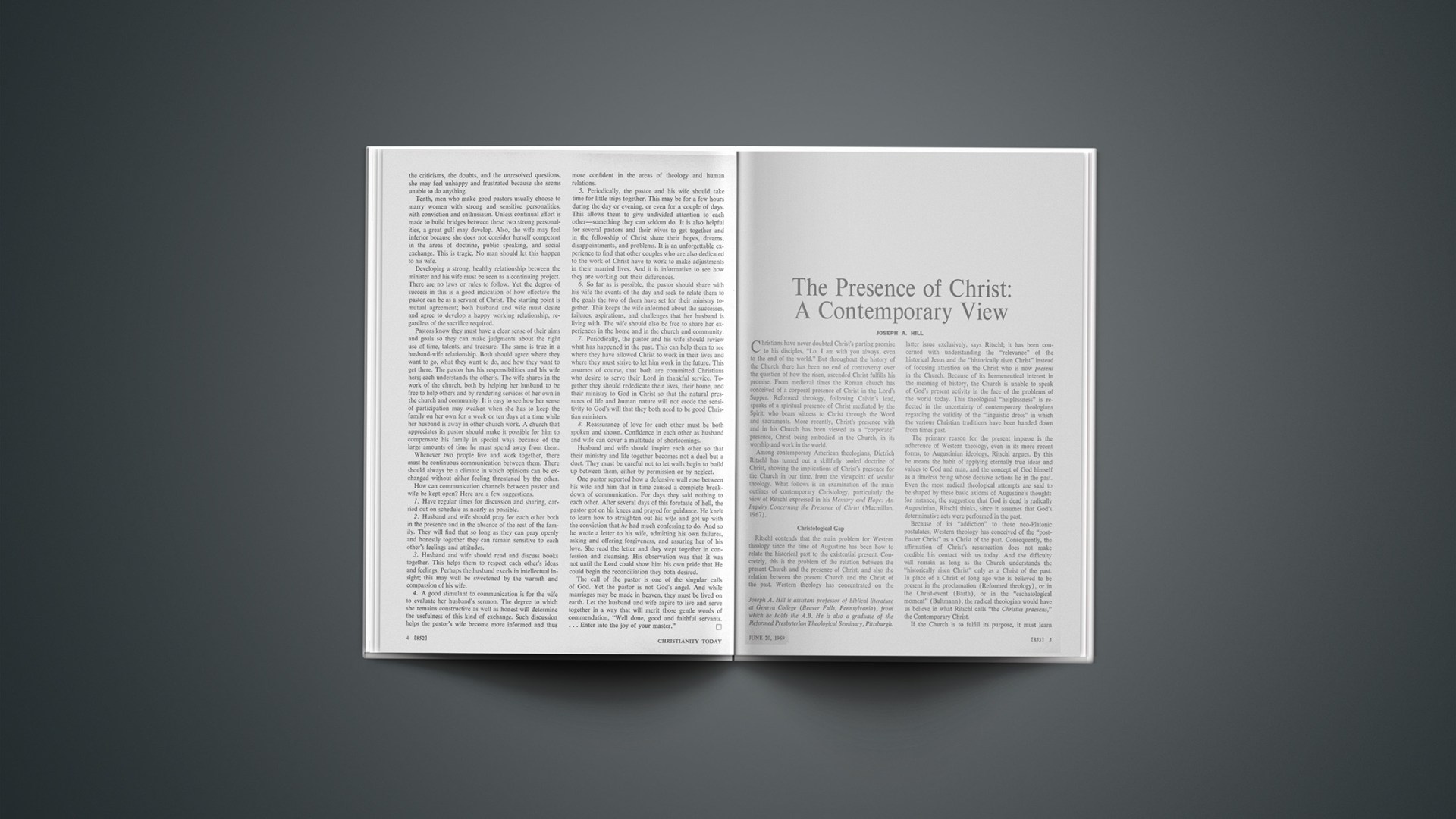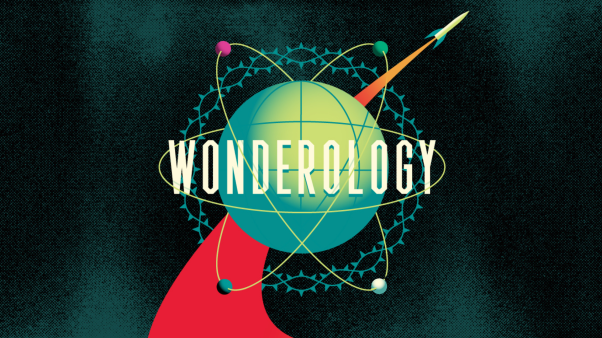Christians have never doubted Christ’s parting promise to his disciples, “Lo, I am with you always, even to the end of the world.” But throughout the history of the Church there has been no end of controversy over the question of how the risen, ascended Christ fulfills his promise. From medieval times the Roman church has conceived of a corporal presence of Christ in the Lord’s Supper. Reformed theology, following Calvin’s lead, speaks of a spiritual presence of Christ mediated by the Spirit, who bears witness to Christ through the Word and sacraments. More recently, Christ’s presence with and in his Church has been viewed as a “corporate” presence, Christ being embodied in the Church, in its worship and work in the world.
Among contemporary American theologians, Dietrich Ritschl has turned out a skillfully tooled doctrine of Christ, showing the implications of Christ’s presence for the Church in our time, from the viewpoint of secular theology. What follows is an examination of the main outlines of contemporary Christology, particularly the view of Ritschl expressed in his Memory and Hope: An Inquiry Concerning the Presence of Christ (Macmillan, 1967).
Christological Gap
Ritschl contends that the main problem for Western theology since the time of Augustine has been how to relate the historical past to the existential present. Concretely, this is the problem of the relation between the present Church and the presence of Christ, and also the relation between the present Church and the Christ of the past. Western theology has concentrated on the latter issue exclusively, says Ritschl; it has been concerned with understanding the “relevance” of the historical Jesus and the “historically risen Christ” instead of focusing attention on the Christ who is now present in the Church. Because of its hermeneutical interest in the meaning of history, the Church is unable to speak of God’s present activity in the face of the problems of the world today. This theological “helplessness” is reflected in the uncertainty of contemporary theologians regarding the validity of the “linguistic dress” in which the various Christian traditions have been handed down from times past.
The primary reason for the present impasse is the adherence of Western theology, even in its more recent forms, to Augustinian ideology, Ritschl argues. By this he means the habit of applying eternally true ideas and values to God and man, and the concept of God himself as a timeless being whose decisive actions lie in the past. Even the most radical theological attempts are said to be shaped by these basic axioms of Augustine’s thought: for instance, the suggestion that God is dead is radically Augustinian, Ritschl thinks, since it assumes that God’s determinative acts were performed in the past.
Because of its “addiction” to these neo-Platonic postulates, Western theology has conceived of the “post-Easter Christ” as a Christ of the past. Consequently, the affirmation of Christ’s resurrection does not make credible his contact with us today. And the difficulty will remain as long as the Church understands the “historically risen Christ” only as a Christ of the past. In place of a Christ of long ago who is believed to be present in the proclamation (Reformed theology), or in the Christ-event (Barth), or in the “eschatological moment” (Bultmann), the radical theologian would have us believe in what Ritschl calls “the Christus praesens,” the Contemporary Christ.
If the Church is to fulfill its purpose, it must learn to interpret the actions of God in the past as a promise that he who fulfilled his Old Testament promise in the advent of Jesus will continue to act in the way of fulfillment because of the present reality of Christ in the Church. Theology is, accordingly, a reflection upon the realms of memory and hope, which are “the dimensions of faith in the Christus praesens.” Tradition, the earliest of which is recorded in Scripture, is the source of the Church’s memory and also the basis of its hope, hope that God, who worked in the past (e.g., in the Exodus and in Jesus), will perform new acts of fulfillment in the present and future. The Church in fact participates in this ongoing work of God; after all, hope is not a passive dimension of faith but is “the matrix of future events”—a fact that has ethical implications.
Hermeneutical Bridges
If the contemporary Church does not sense the reality of Christ today, the fault, Ritschl believes, lies with hermeneutics, which has not succeeded in bridging the gap between revelational past and existential present. Christology in current theological discussion is concerned with the significance of history. It is Collingwood’s concept of history that gives contemporary hermeneutics its method: an examination, not of past events as such, but of documents that are interpretations of the events. Collingwood’s understanding of history coupled with a part of Heidegger’s philosophy of existence enabled theologians to “analyze the existence, or the self-understanding, of the individual who finds himself related to past events …” (Memory and Hope, p. 37). The outcome of this methodology is for Bultmann the idea of the kerygma as “eschatological event” in which Christ’s birth, death, and resurrection recur in a believer’s life; and for Gerhard Ebeling it is the thought that the kerygma does, after all, speak of “the historical Jesus,” i.e., the “historicity” or self-understanding of Jesus. Thus the new hermeneutics, with the help of modern language analysis, strives to make “relevant” the meaning of past events, or rather of biblical texts that represent past events.
But Ritschl argues that these approaches presuppose, no less than did Augustine’s literal understanding of the Gospel, a static, timeless, history-less God. Consequently, they amount to a mere reenactment and confirmation of what God has revealed in the past, and they represent an essentially deistic concept of God.
In offering his own solution to the problem of correlating existence and revelation, Ritschl makes the Christus praesens the starting point for hermeneutics. The Church is not limited to an understanding of revelatory events in the past (recorded in Scripture), but possesses the continuing revelation made possible by the Christ who continues to be present in the Church. God’s self-revelation did not end with the completion of the New Testament, for the “risen Christ” has, in post-apostolic times, made known his presence through “a multitude of forms of expression.”
Viewing the principle of sola scriptura as a major hindrance to the Church’s understanding of Christ’s up-to-the-moment presence, Ritschl would replace it with what Albert Outler has called the principle of sola Christus; this Ritschl sees as “the measure of the permissible boundaries of Christian teaching” (p. 71). When properly applied, this principle will prevent acceptance of those parts of the “later tradition” (i.e., non-biblical) that do not reflect a genuine recognition of the Christus praesens. Ritschl’s rejection of the sufficiency of Scripture raises the question of authority in religion and ethics, and suggests the answer that in this form of the new theology, too, the ultimate authority is the assumedly autonomous religious consciousness of man.
Ritschl thinks the dilemma of Western theology (revelation-verification versus world-verification) might have been avoided if the Church in the West had received the “best part” of Greek theological tradition—especially the emphasis on worship and prayer in which that theology is embedded.
Since liturgy is a primary concern in connection with theology, the Church needs to understand more precisely the nature of doxological language as against theological language. Recent controversy over “non-objectifying” language and the running debate about the difficulties of “speaking of God” point to a need of recognizing the prayer-like language of Scripture itself, says the radical theologian. In these areas of theological problem-solving, it is again the Christus praesens who is given a central place. Christ’s presence recognized in the Church elicits doxology; but doxology, while it speaks of God, is primarily a speaking to God. These two modes of speaking are distinguished as theological language and doxological language, respectively.
The Difference
In emphasizing this distinction Ritschl follows the language theory used by Paul van Buren. Ritschl, unlike van Buren, does not dispense with the word “God”; but he does suggest that it is “dogmatically senseless to confess ‘Christ’ but not ‘God,’ although it may be necessary for ethical reasons to be silent about God.” In any case, God is known in his historical association with Israel as Yahweh, and “it is because of this name that ‘speaking of God’ is not based on the trans-empirical and trans-historical” (p. 180). It is really, however, the Christus praesens who constitutes the “heart of God,” or the “guts of God.” Christ is the “that” in God which “reminds” God of his faithfulness to man, and which “reminds” man of his memory and hope, and invites him to use doxological language. But doxological language is not to be understood as descriptive of a God above the world and above history. The language of the Church expresses the fact that in Jesus Christ God has a history, a history that is expressed in the modes of promise and fulfillment. These language modes are received and understood by the Church as memory and hope, which, however, do not exclude the present, but, in fact “constitute the present as that which was expected and which will be remembered.” Theological language, on the other hand, does not consist of “is-sentences” about God; rather, it is a reflection upon the memory-hope tradition of the Church.
Ritschl applies Kant’s distinction between analytical judgments and synthetical judgments to the hermeneutical problem. The former are simple historical statements like “Samaria was destroyed,” while the latter are interpretative statements with God as either subject or predicate, e.g., “The destruction of Samaria was a judgment of God.” But such a synthetical proposition constitutes prayer or doxology in its intent, as if to say to God, “You are the one who destroyed Samaria.” It is here that we see the proximity of Ritschl’s language analysis to that of van Buren, who similarly distinguishes cognitive propositions that are subject to the verification principle of logical positivism from non-cognitive propositions that claim to be, not descriptions of reality as such, but rather statements about a certain way of looking at reality (Paul M. van Buren: The Secular Meaning of the Gospel, Macmillan, 1963, pp. 13–17, 101–6). It was Ludwig Wittgenstein who developed this type of language analysis at Cambridge University in the 1930s. More recently, the application of it to theological reflection has made the “gospel” acceptable to those who, adhering to the philosophy of Kant, assert that it makes no sense to speak of God unless we mean Jesus.
Incarnation Christology
It is in terms of the Christus praesens concept that Ritschl develops his Christology. He rejects the Chalcedonian doctrine of Christ because incarnation Christology with its dual-nature concept presupposes two distinct “worlds,” a timeless concept of God, and a Christ before Jesus; all of this led, in Western theological tradition, to an “imbalance of the natures of Jesus Christ himself,” one nature being emphasized at the expense of the other. This dualism resulted in the separations that have posed major problems in theology: the separation of Christology and soteriology (Augustine), of Christ’s present priestly work and the priestly function of the Church (medieval ecclesiology), of Christ’s personal and “cosmic” work (Luther), and of the historical Jesus and the “risen Christ” (nineteenth-century liberalism).
According to Ritschl, the proper starting point for Christology in a thoroughly non-supernatural theology is not the Incarnation—even in a demythologized sense—but the resurrected Christ who is present in the Church. Away with the two natures of Christ and the dualism that separates God and Christ! The Chalcedonian formulation of an incarnated God and two natures is no longer credible, for it implies a separation between Christ and his work and a discontinuity between Christ’s work and the Church’s task. Ritschl’s concept of a God who is wholly identical with a Christ who is wholly identical with his priestly work in behalf of the world is not radically different from Karl Barth’s idea of God.
Applying language-use distinctions to Christology, Ritschl suggests that traditional terms like Son of God and Son of man, which appear to designate two natures in Christ, may continue to be used in the Church, but that they should be understood as synthetical judgments or doxological language. Theologically, however, “Jesus should be described not in terms of being, location or relation of natures, but of functions” (p. 215). The priesthood of Jesus suggests the use of functional terms like Yahweh’s call/man’s response, Yahweh’s will/man’s obedience, Yahweh’s word/man’s reply. These “neutral” terms indicate not two natures in Christ but a dual function: Jesus does the works of God; he also does the works of man. The term “God,” when applied to Jesus, does not mean that Jesus is God any more than the term “man” means Jesus is mankind. The use of these terms in the new Christology signifies function rather than being: in his priestly function Jesus “represents” both God and man.
Despite an essentially anthropological Christology, Ritschl continues to speak in trinitarian terms. But in this too the terms “God,” “Christ,” and “Holy Spirit” have a functional significance rather than an ontological one. “Our implicit contention is … a trinitarian thought: the Christus praesens is not other than God, he is God’s identity” (p. 223). Ritschl’s God-Christ-Holy Spirit identity utilizes “the so-called heresy of modalism,” which, he thinks, “has at least one advantage, viz., its cognizance of the fact that God has a history which affects his people …” (ibid.). It is clear that radical theology offers us a non-ontological trinity, and that consequently we are left without an eternal One-and-Many, in reference to which alone the priestly work of Christ, “standing as the [temporal] One for the many,” has any ultimate meaning.
The ethic of the contemporary Church should be no less Christ-centered than its theology, say the radical theologians. But being Christ-centered means involvement with the world, involvement with man. The true criterion for ethics is to be found, not in the law as a timeless expression of God’s will (orthodox Christianity), nor in love as a timeless ideal (the new morality), but in the confession that Christ is present in the Church. Belief in Christ’s presence implies that “God intends man, God seeks man … God is for man.” The Church’s ethical mandate is thus made clear, for “the orientation on this creed implies directly that man must also ‘intend’ man, and ‘seek’ man, and not want man’s death but his life; in short, that man must be for man, that he hopes for man” (p. 199). This is to say that the Church is incorporated into Christ’s priestly work, which assumes the form of ora et labora: vicarious prayer and work on behalf of others—especially involvement in the cultural and political structures of society. This task of the Church is coincident with the presence of Christ, who, being embodied as the Church, liberates the members to “solidarity with their fellow men … enabling them to be concretely for man” (ibid.).
It appears that Dietrich Ritschl has patterned his conception of the Church after that of Dietrich Bonhoeffer. The latter spoke of the Church as “Christ existing as community,” a phrase that is parallel to Ritschl’s description of the Church as “the mode of Christ’s presence.” Alvin Porteous has observed that Bonhoeffer’s theologizing “was from beginning to end a sustained effort to elucidate the way in which Christ takes form in his body the Church as an anticipation of the formation of all men into their true humanity” (Prophetic Voices in Contemporary Theology, Abingdon, 1966, p. 166).
The Fathers knew, of course, that the Church in the world is Christ’s body, and they expressed the relationship in these terms: Ubi Christus, ibi ecclesia. Secular theologians have it turned around: Wherever the Church is, there is Christ.
To whatever extent modern existentialist theology is a historical outgrowth of Augustinian theology, it does not proceed, in any of its forms, on Augustine’s presupposition of a truly transcendent, eternal God who speaks infallibly in the Bible. The “timeless God” of existentialist theology is not the same as the Augustinian thought of the “eternal God.” The timeless God of modern theology and modern philosophy is a “God” who exists above ordinary time in a condition of pure duration. Contemporary theology no doubt has been influenced more or less by the Augustinian tradition, but it has been shaped to a much greater extent by modern philosophy, particularly that of Immanuel Kant and the post-Kantians.
Ritschl stands with van Buren on the side of a thoroughly non-metaphysical theology. But he thinks that van Buren has not entirely avoided metaphysics. Van Buren attempts, but without real success, to demonstrate by means of linguistic analysis that modern man can “have access to the Easter event in a merely empirical-pragmatic way” without employing metaphysical concepts. Ritschl questions whether the philosophical problem, Cognition without metaphysics?, is relevant at all to theology. He would theologize even more concretely than does van Buren. “Theology,” he states, “is concerned with the one who makes necessary and possible the recognition of himself. It is clear, however, that the language in which this recognition is verbalized is not derived from the trans-empirical; on the contrary, the Bible and the tradition of the Church affirm that no other than this-worldly language exists” (p. 167). There is no necessity, therefore, that Christians be concerned with “metaphysical speculation”; there is no point in asserting “the existence of an invisible world,” since “God’s will and work with the world cannot be had without or outside the world” (p. 168). The Church’s “awareness” of God’s work within the world and within history is the presence of Christ.
It is clear that the positions of these radical theologians, Ritschl and van Buren, are radically different neither from each other nor from those of existentialist theologians. Both Ritschl and van Buren, together with the existentialist theologians, begin their understanding of both Scripture and existence with the Kantian dictum that we cannot know the “reality” that might conceivably exist behind or above the world of experience and appearance—the phenomenal world.
In the last analysis, the contemporary Ritschlian Christ is not the Christ of the inscripturated divine revelation but a Christ of human tradition, for the Christus praesens is a projection of the religious awareness of man. And a Christ of human projection is an absent Christ—whether he is projected from past to present in individual “personal encounter,” as in existentialist theology, or from the corporate consciousness of the Church into the world, as in secular theology.
A spiritual presence of Christ is not less concrete than the “corporate” presence of Christ would be, for he is present not in spirit (a vague awareness that persists in the Church) but in the Spirit, who presents Christ to us in Word and deed.
on experience
The person who just wants religious experience really has no experience at all. He is one who gets cheated. He who receives Christ experiences something, but he hardly notices it. The wonder of the new life, the joy of forgiveness, and the liberation from fear keep him looking constantly to this figure from whom streams of living water flow into his life, reclaiming the desert of his lost heart and working the miracle of new beginning.—Helmut Thielicke in I Believe the Christian’s Creed. Copyright © 1968 by Fortress Press. Used by permission.










